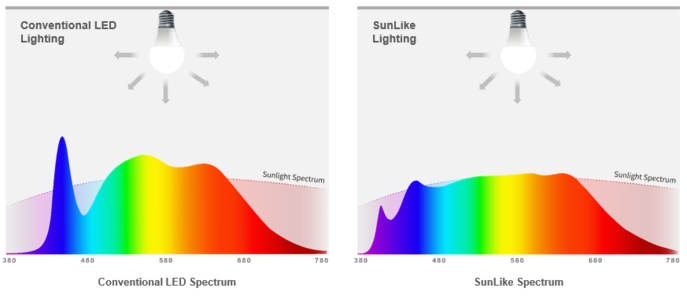A leading global innovator of LED products and technology, announced that following Seoul National University in Korea and Basel University in Europe, a research team found that exposure to short-wavelength enriched light with daylight-like spectrum improves key components of learning such as working memory, cognitive processing speed, and testing accuracy.
The clinical trial began in 2019, conducted by the Division of Sleep and Circadian Disorders at Brigham and Women’s Hospital, a teaching affiliate of Harvard Medical School, and included college-aged adults. The results from the study clearly showed the effectiveness of improving procedural learning.\

Comparison of cognitive performance with exposure to conventional lighting or SunLike lighting
Shadab Rahman, PhD MPH, a researcher in the Division of Sleep and Circadian Disorders at Brigham and Women’s Hospital and Assistant Professor of Medicine at Harvard Medical School, led the study along with Leilah Grant, PhD, Melissa St. Hilaire, PhD, Steven Lockley, PhD, and other researchers at the Brigham. Dr. Rahman said, “Even if the color temperature and brightness are the same, light with different spectra may affect non-visual responses to light exposure, including those of circadian rhythms and cognition, differently. In this experiment, we found improvement in working memory, cognitive processing speed, procedural learning, and testing accuracy with young adults under daylight-like light spectrum lighting compared to conventional-LED spectrum lighting. This is an important result that can inform lighting choices for indoor use to enhance students’ learning and memory function.”
The daylight-like spectrum lighting used in the study was provided by makers of SunLike. SunLike is an optical semiconductor technology that reproduces the natural sunlight spectrum curve, that is, the intensity of light for each wavelength of red, orange, yellow, green, blue, and purple. This new concept of LED light source embodies almost the same characteristics of natural light and is optimized for human 24-hour circadian rhythm accordingly.
There has been an increase in research activity on the relationship between light and human bio-function, including a recent scientific study focusing on the effects of light spectrum on sleep quality, visual comfort, well-being and daytime alertness conducted by Prof. Christian Cajochen and his team at the University of Basel in Switzerland, entitled: ‘Effect of Daylight LED on Visual Comfort, Melatonin, Mood, Waking Performance, and Sleep,’ published in the Journal of Lighting and Research Technology on March 24, 2019. In addition, in an experiment at Seoul National University College of Medicine in July 2018, it was demonstrated that vitality and alertness were increased when SunLike LED lighting was used.

Spectrum comparison under the same shape and color lighting condition

